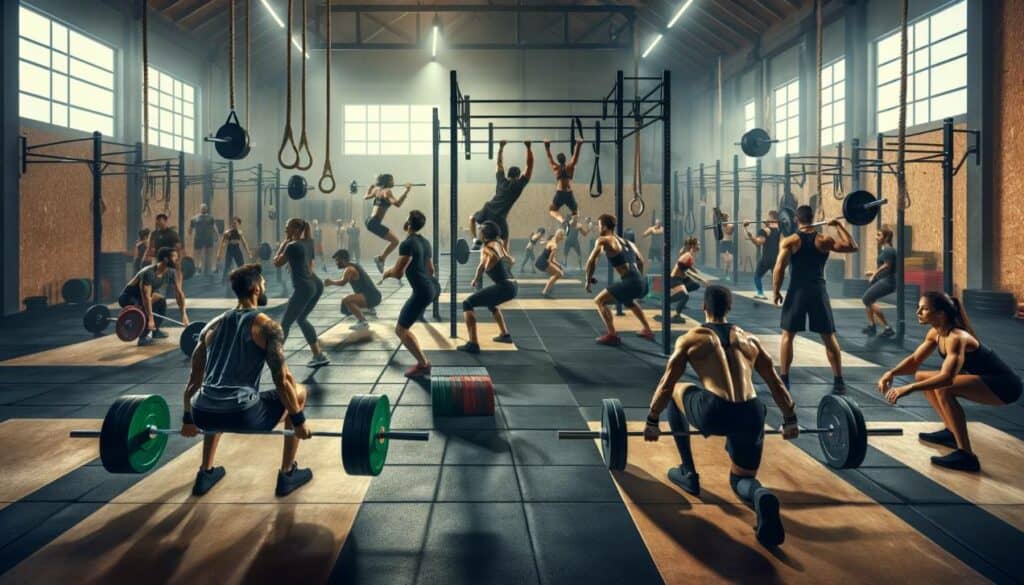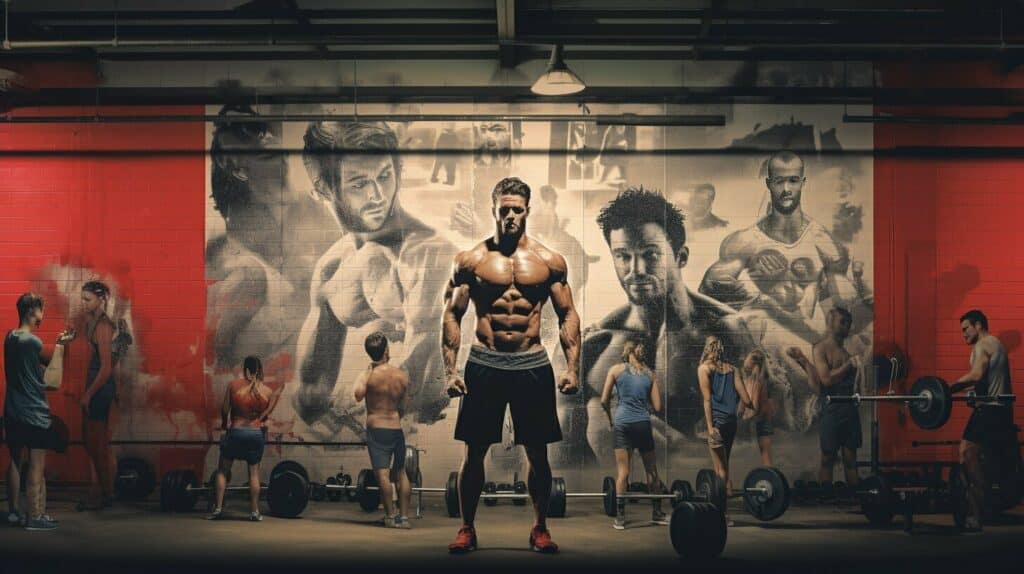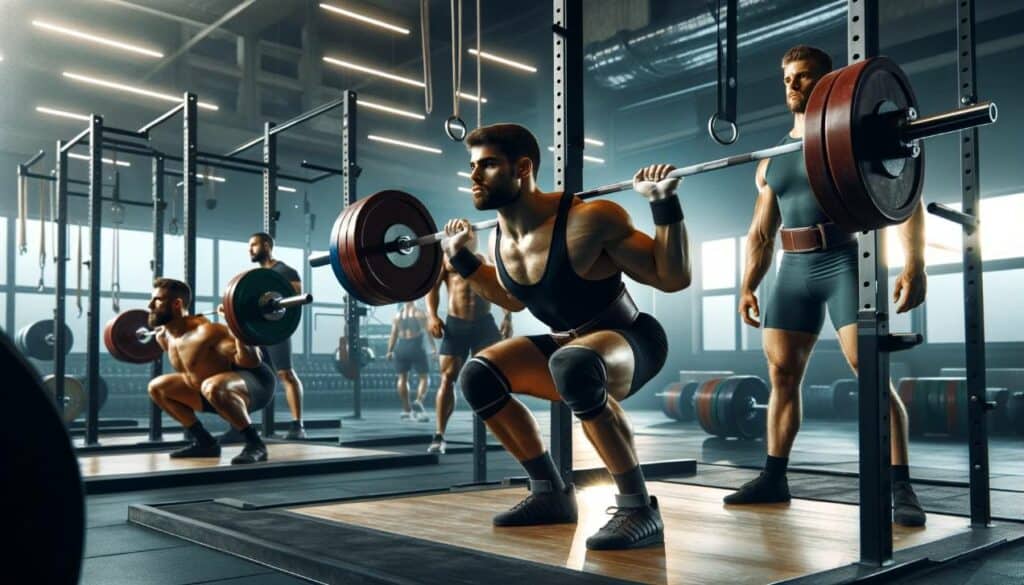Are you torn between choosing CrossFit or Powerlifting as your fitness regimen? Both disciplines offer unique benefits and have their own training approaches. This article will explore the key differences between CrossFit and Powerlifting, helping you determine the best fit for your goals and preferences.
Key Takeaways:
- CrossFit combines various sports exercises, while Powerlifting focuses on three main lifts: squat, bench press, and deadlift.
- CrossFit is known for its high intensity and functional movements, while powerlifting emphasizes maximum strength in the lifts.
- CrossFit offers cardiovascular benefits, movement variety, an inclusive community, and scalability for all fitness levels.
- Powerlifting can increase bone density, provide dedicated strength training, promote muscle building, and aim to increase strength.
- Consider your fitness goals, preferences, and the specific benefits each discipline offers to make the right choice for you.
What Is CrossFit?
CrossFit is a fitness regimen that combines various strength and barbell sports such as Olympic weightlifting, powerlifting, strongman, and gymnastics. It is known for its high-intensity workouts and functional movements that work multiple muscle groups simultaneously. CrossFit aims to improve overall fitness and performance by focusing on strength, endurance, flexibility, and coordination.
Unlike traditional workouts that isolate specific muscle groups, CrossFit incorporates functional movements that mimic real-life activities. These movements include lifting, pushing, pulling, and squatting. CrossFit aims to enhance overall physical capabilities and improve athletic performance in various domains by training the body to perform these functional movements at high intensity.
CrossFit has gained popularity as both a fitness program and a professional sport. The CrossFit Games, held annually, showcase the world’s fittest athletes competing in challenging workouts. Whether you’re an athlete looking to improve performance, a fitness enthusiast seeking a dynamic workout routine, or someone looking to enhance overall fitness, CrossFit offers a diverse and challenging training approach.
Benefits of CrossFit
- Improved cardiovascular health: CrossFit’s high-intensity workouts elevate heart rate and promote cardiovascular endurance.
- Varied movement patterns: CrossFit incorporates a wide range of functional movements, preventing monotony and engaging multiple muscle groups.
- Inclusive community: CrossFit fosters a supportive and inclusive community where individuals of all fitness levels can challenge themselves and cheer each other on.
- Scalable for all levels: CrossFit workouts can be scaled and modified to accommodate beginners, allowing individuals to progress at their own pace.
- Strength and muscle building: With its emphasis on barbell sports and high-repetition bodyweight exercises, CrossFit helps develop strength and build lean muscle mass.
CrossFit offers a range of benefits that can enhance your overall fitness and well-being. One of the key advantages is improved cardiovascular health. The high-intensity workouts in CrossFit push your heart rate up, increasing your endurance and strengthening your cardiovascular system. These intense workouts also help you burn calories effectively, making CrossFit a great weight-loss choice.
Another benefit of CrossFit is the variety of movements it incorporates. CrossFit workouts challenge your body in multiple ways and prevent boredom from weightlifting to gymnastics and everything in between. The diverse range of movements interests your workouts and helps you build functional strength, agility, and flexibility.
“CrossFit is not just a workout, it’s a community. The inclusive nature of CrossFit creates a supportive environment where individuals of all fitness levels can thrive. Whether you’re a beginner or an experienced athlete, you’ll find a welcoming community that encourages and motivates you to reach your fitness goals.”
Scalable and Suitable for All Levels
CrossFit is suitable for individuals of all fitness levels. The workouts can be scaled and modified to accommodate beginners and advanced athletes. CrossFit coaches and trainers are skilled at adapting the exercises to meet your needs, ensuring you can safely participate and progress at your own pace. Whether you’re looking to build strength, improve your athletic performance, or stay fit, CrossFit can be tailored to help you achieve your goals.
Strength and Muscle Building
CrossFit incorporates weightlifting movements and high-repetition bodyweight exercises, making it an effective program for strength and muscle building. The combination of resistance training and high-intensity workouts stimulates muscle growth, improving strength and a more toned physique. If your goal is to build lean muscle mass, CrossFit can provide the right balance of strength training and cardiovascular exercise to help you achieve your desired results.
| Benefits of CrossFit | |
|---|---|
| Improved cardiovascular health | Enhances endurance and strengthens the heart |
| Varied movements | Prevents workout boredom and builds functional strength |
| Inclusive community | Motivates and supports individuals of all fitness levels |
| Scalable and suitable for all levels | Adapts to individual needs and goals |
| Strength and muscle-building | Combines resistance training for muscle growth |
Crossfit exercises and training methods
Crossfit workouts typically involve a combination of weightlifting, cardiovascular exercises, and bodyweight movements. Some common exercises include squats, deadlifts, bench press, and Olympic lifting. Crossfit gyms are known for their supportive community environment and group workouts.
What Is Powerlifting?

Powerlifting is a strength sport centered around three main lifts: squat, bench press, and deadlift. As a powerlifter, your primary focus is building strength and maximizing your performance in these exercises. Unlike other fitness regimens, powerlifting requires specialized training and technique to lift the heaviest weights possible.
Each of the three main lifts in powerlifting targets different muscle groups and requires a combination of brute strength, stability, and control. The squat primarily engages your lower body muscles, including your quadriceps, hamstrings, and glutes. The bench press targets your chest, shoulders, and triceps, while the deadlift works your posterior chain, including your back, hips, and leg muscles. Powerlifters aim to increase their one-rep max, the maximum weight they can lift for a single repetition in each lift.
Powerlifting training programs are designed to help you progressively increase your strength and improve your squat, bench press, and deadlift technique. These programs typically involve heavy lifting at lower repetitions, followed by adequate rest and recovery for muscle growth and strength adaptation. Powerlifting is a challenging sport that requires dedication, discipline, and a commitment to continuous improvement in strength and technique.
| Lift | Muscles Targeted |
|---|---|
| Squat | Quadriceps, Hamstrings, Glutes |
| Bench Press | Chest, Shoulders, Triceps |
| Deadlift | Back, Hips, Leg Muscles |
Powerlifting offers a unique challenge and sense of accomplishment as you progressively increase your strength and conquer new personal records. It can be a rewarding sport for individuals who enjoy pursuing raw strength and pushing their physical limits.
Benefits of Powerlifting
Regarding strength training, powerlifting offers many benefits that can take your fitness journey to the next level.
One of the key advantages of powerlifting is its ability to increase bone density. Powerlifting stimulates bone growth by subjecting your body to heavy loads and intense training, making your bones stronger and more resistant to fractures. This is especially beneficial for individuals concerned about osteoporosis and overall bone health.
Powerlifting is also synonymous with dedicated strength training. Unlike other fitness programs focusing on various exercises, powerlifting hones in on three main lifts: squat, bench press, and deadlift. By training specifically for these lifts, you can achieve incredible strength gains and improve your performance in these movements.
In addition to building raw strength, powerlifting also contributes to muscle building. The constant progression and heavy workload of powerlifting workouts stimulate muscle growth, increasing muscle mass over time. While powerlifting may not aim to create a muscular physique like bodybuilding, it undoubtedly plays a significant role in muscle development.
Its singular goal of increasing strength sets powerlifting apart from other fitness regimens. With powerlifting, you have a clear objective and target to work towards, which provides structure and focus in your training. This clarity of purpose can be highly motivating and help you stay committed to your fitness goals.
Bodybuilding: The Pursuit of Muscle Aesthetics

What is bodybuilding?
Bodybuilding, the most popular discipline among the three sports, centers around building muscle mass and sculpting the body for aesthetic purposes. It requires discipline and dedication to achieve a well-defined physique. Bodybuilders often focus on specific muscle groups and follow strict training regimens and nutrition plans to achieve their desired results.
How does bodybuilding compare to CrossFit and Powerlifting?
Bodybuilding differs from CrossFit in that it places more emphasis on muscle aesthetics rather than overall fitness. Unlike powerlifting, which focuses solely on strength, bodybuilding aims to build muscle mass while achieving a balanced and symmetrical physique.
Building muscle mass in bodybuilding
Bodybuilders follow a structured training program that involves lifting weights to stimulate muscle growth. They typically perform multiple sets and repetitions with moderate to heavy weights to target specific muscle groups. Nutrition also plays a crucial role in bodybuilding, with individuals following strict diets to support muscle growth and fat loss.
Bodybuilding competitions and training techniques
Bodybuilding competitions showcase individuals’ physiques based on criteria such as muscle size, symmetry, definition, and stage presence. Competitors undergo rigorous training and dieting to achieve peak condition for competitions. Bodybuilders use isolation exercises, supersets, and drop sets to target specific muscle groups.
Bodybuilding vs Powerlifting
How does CrossFit compare to bodybuilding and powerlifting?
Crossfit is a unique form of training that combines elements from various sports and disciplines. It differs from bodybuilding because it emphasizes overall fitness rather than muscle aesthetics. Similarly, it differs from powerlifting, focusing on a wide range of physical skills rather than just strength.
Crossfit vs Powerlifting vs Bodybuilding
While bodybuilding is the most popular discipline among these three sports, Crossfit and Powerlifting offer unique benefits that appeal to different individuals. Crossfit is the right fit for those seeking a well-rounded fitness regimen that challenges them in multiple areas. On the other hand, powerlifting is ideal for individuals who prioritize strength development and excel in specific lifts.
It is worth noting that Crossfit gyms are radically different from commercial gyms as they don’t typically have traditional cardio equipment or weight training machines. Crossfit people usually work out in groups and follow a WOD, fostering a strong sense of community within the fitness community. Conversely, commercial gyms tend to offer a variety of equipment that caters to individuals with different fitness goals.
In conclusion, these three sports – Crossfit, bodybuilding, and powerlifting – have different purposes and attract individuals with diverse fitness goals. Crossfit focuses on overall fitness and performance in ten general physical skills, while powerlifting emphasizes strength and endurance through heavy lifting. Bodybuilding first came into the limelight with figures like Arnold Schwarzenegger, and it centers around building muscle mass and sculpting the body. Each discipline requires discipline and offers unique benefits for those looking to improve their health and fitness.
Comparison Table
| Feature | CrossFit | Powerlifting | Bodybuilding |
|---|---|---|---|
| Primary focus | Generalized fitness | Maxing out 1-3 lifts | Building muscle mass |
| Intensity | High-intensity | Moderate-to-high intensity | Moderate-to-low intensity |
| Movement variety | High | Low | Moderate |
| Equipment | Varied, including weights, barbells, dumbbells, gymnastic equipment | Barbell, bench press, squat rack, deadlift platform | Free weights, resistance machines |
| Class structure | Often group classes led by trainers | Individual or small group sessions with trainers | Individual or group sessions with trainers |
| Training frequency | 3-5 days per week | 2-3 days per week | 3-4 days per week |
| Rest time | Short rest periods between sets | Longer rest periods | Longer rest periods |
| Suitability | Athletes and those seeking a challenging workout | Strength athletes and those seeking to improve their PRs | Bodybuilders and those seeking to build muscle |
| Goals | Overall fitness, improved cardiovascular health, injury prevention | Maxing out squat, bench press, and deadlift | Building muscle mass |
| Benefits | Improved strength, endurance, and power | Improved strength, power, and mental toughness | Improved muscle mass, symmetry, and definition |
| Potential drawbacks | Maxing out squats, bench press, and deadlift | Limited muscle mass gains | Limited strength gains |
| Atmosphere | Competitive and energetic | Focussed and disciplined | Calm and controlled |
| Ideal for | Those who enjoy challenging workouts and want to improve their overall fitness | Those who want to focus on specific strength goals | Those who want to build muscle mass and improve their physique |
FAQs
What is the difference between CrossFit and Powerlifting?
CrossFit is a high-intensity fitness program that combines multiple strength and barbell sports, while powerlifting focuses on lifting the most weight in three main lifts: squat, bench press, and deadlift.
What is CrossFit?
CrossFit is a fitness regimen that incorporates various exercises from different sports, such as Olympic weightlifting, powerlifting, strongman, and gymnastics. It is characterized by high-intensity, functional movements performed in rapid succession.
What are the benefits of CrossFit?
CrossFit improves cardiovascular health, offers movement variety, fosters an inclusive community, and promotes strength and muscle building.
What is Powerlifting?
Powerlifting is a strength sport focusing on three main lifts: squat, bench press, and deadlift. Participants aim to lift the most weight in these exercises.
What are the benefits of Powerlifting?
Powerlifting increases bone density, provides dedicated strength training, contributes to muscle building, and offers a singular goal of increasing strength.
Conclusion
In summary, CrossFit, powerlifting, and bodybuilding are three distinct strength sports with different goals and training approaches. Crossfit focuses on overall fitness and functional movements, powerlifting tests maximal strength in specific lifts, while bodybuilding aims to build muscle mass and achieve an aesthetically pleasing physique.
Ultimately, choosing these sports depends on your personal goals and preferences. CrossFit may be the right fit if you’re looking for a well-rounded fitness program that physically and mentally challenges you. Powerlifting might be for you if you have a knack for lifting heavy weights and enjoy the competitive aspect of strength sports. And if you’re a fan of muscle aesthetics and want to sculpt your physique, bodybuilding could be your calling.
Remember, whichever sport you choose, consistency and dedication are key to achieving your goals. So lace up your shoes or strap on your lifting belt – it’s time to embark on your strength journey!
Source Links
- https://thechronicleclc.com/801/health-science/the-impacts-of-crossfit-vs-powerlifting/
- https://liftbigeatbig.com/crossfit-vs-powerlifting/
- https://generationiron.com/crossfit-bodybuilding-powerlifting/
As a veteran fitness technology innovator and the founder of GearUpToFit.com, Alex Papaioannou stands at the intersection of health science and artificial intelligence. With over a decade of specialized experience in digital wellness solutions, he’s transforming how people approach their fitness journey through data-driven methodologies.
